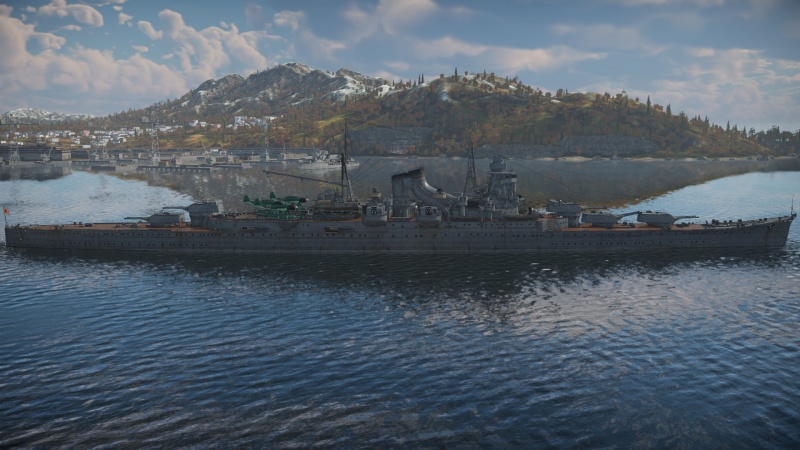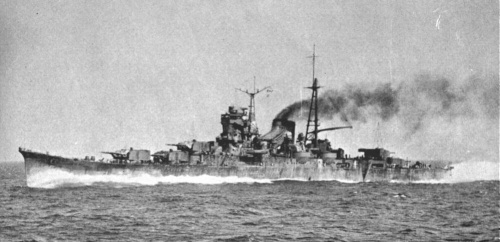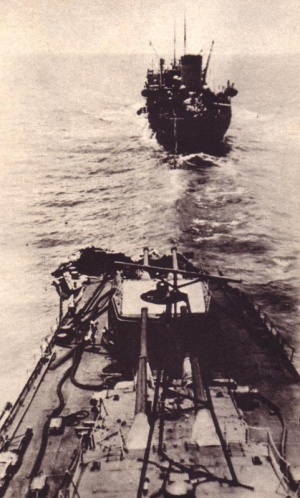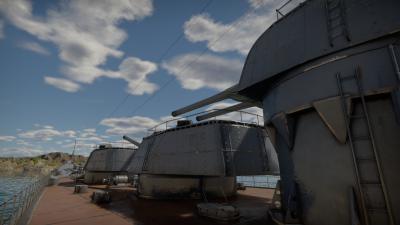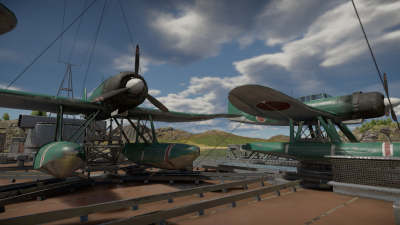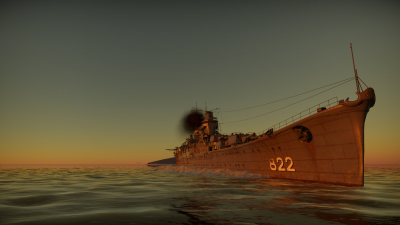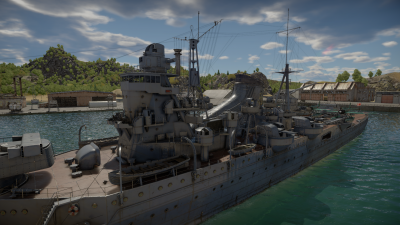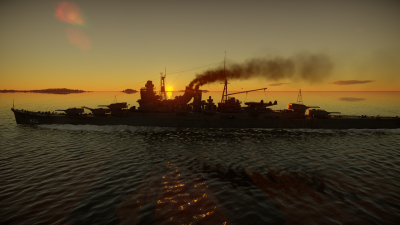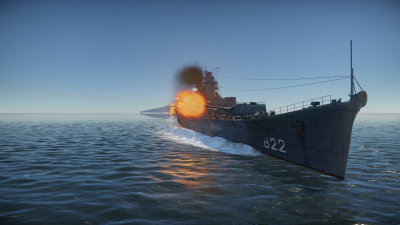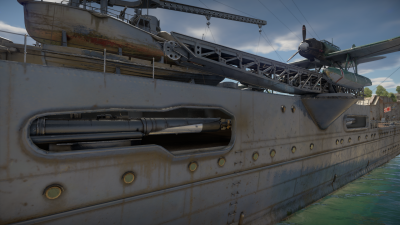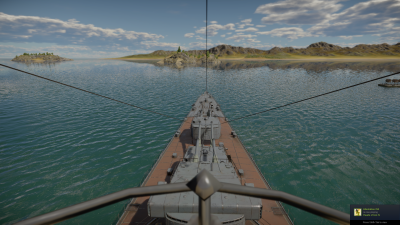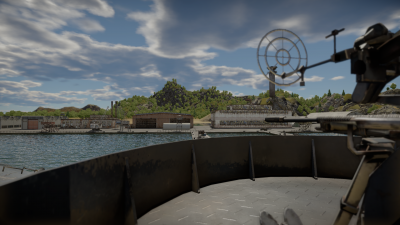IJN Mogami
| This page is about the Japanese heavy cruiser IJN Mogami. For other uses, see Mogami (Family). |
Contents
Description
Mogami (最上, namesake: Mogami River) was a Japanese heavy cruiser commissioned July 1935. Sea trials discovered huge instability of her hull, which forced refitting her with a large hull bulges, addressing the issue. Since 1940, she participated in the occupation of French Southeast Asia with her sister ship Mikuma, and after the Pearl Harbour attacks in December 1941, she covered the invasion of British Borneo where, along with Mikuma and escorting destroyers, they destroyed the American cruiser USS Houston and the Australian cruiser HMAS Perth; in June 1942, during the Battle of Midway, Mogami collided with Mikuma due to communication errors, and while attempting to withdraw, she was attacked by numerous American aircraft, leading to Mikuma's sinking and Mogami's return to port for repairs, during which she was converted into an aircraft-carrying cruiser with a flight deck for seaplanes and enhanced anti-aircraft armament. In June 1944, she participated in operations in the Philippines but retired after the loss of Japanese air superiority. In October 1944, during the Battle of Leyte Gulf, she was engaged by American forces, suffered damage from USS Portland, collided with the Japanese cruiser Nachi resulting in fires and explosions that disabled her engines, was further disabled by American cruisers and aircraft. An order was given to abandon ship, after which her empty husk remained afloat for several hours until she sank. Her wreck was located in 2019 by R/V Petrel, 1,450 m below the surface.
The Mogami-class, IJN Mogami, 1940 was introduced in Update 1.91 "Night Vision". She is most notable for replacing the 155 mm primary guns of her sister ships with the 203 mm guns known from vessels such as Tone. Similarly to her sisters, she is a very capable cruiser with decent survivability, good mobility, outstanding torpedo armament, and two, this time modernised, floatplanes that can help with winning games through capturing points. Overall, she is an interesting alternative to Suzuya, with the choice of main guns largely coming down to personal preference, as the 203 mm guns still don't address the biggest issue of all the heavy cruisers in such a high BR - inability to effectively counter battleships.
General info
Survivability and armour
The IJN Mogami is one of the most well protected cruisers in the game, with 140 mm of RHA covering the entire front and rear ammunition stowages, 100 mm of RHA protecting the engine compartment, 105 mm of RHA bulkheads, though this will NOT stop other heavy cruisers from ammoracking you if you do not angle. The ship has 910 crew which is just mediocre for a heavy cruiser. The major downside of this ship is its extremely thin (25.4 mm) turret armour so users will have a hard time dealing with HE spam from US destroyers and light cruisers.
Mobility
| Mobility Characteristics | |||
|---|---|---|---|
| Game Mode | Upgrade Status | Maximum Speed (km/h) | |
| Forward | Reverse | ||
| AB | |||
| Upgraded | |||
| RB/SB | |||
| Upgraded | |||
The ship can reach a max speed of 64 km/h (RB), with the complete rudder's turning time of 4.05 seconds (aced crew) which is one of the best for heavy cruisers.
Modifications and economy
Armament
Primary armament
The IJN Mogami is equipped with 5 turrets of dual 20 cm/50 3rd year type No.2 cannons, reload time: 13.94s (stock crew) and 12s (aced crew).
| Penetration statistics | |||||||
|---|---|---|---|---|---|---|---|
| Ammunition | Type of warhead |
Penetration @ 0° Angle of Attack (mm) | |||||
| 1,000 m | 2,500 m | 5,000 m | 7,500 m | 10,000 m | 15,000 m | ||
| Type 0 HE | HE | 61 | 61 | 61 | 61 | 61 | 61 |
| Type 91 AP | APHEBC | 362 | 321 | 263 | 218 | 182 | 139 |
| Type 0 HE-TF | HE-TF | 61 | 61 | 61 | 61 | 61 | 61 |
| Shell details | ||||||||||||
|---|---|---|---|---|---|---|---|---|---|---|---|---|
| Ammunition | Type of warhead |
Velocity (m/s) |
Projectile mass (kg) |
Fuse delay (s) |
Fuse sensitivity (mm) |
Explosive mass (TNT equivalent) (kg) |
Ricochet | |||||
| 0% | 50% | 100% | ||||||||||
| Type 0 HE | HE | 835 | 125.4 | 0 | 0.1 | 8.57 | 79° | 80° | 81° | |||
| Type 91 AP | APHEBC | 835 | 125.85 | 0.05 | 9 | 3.26 | 48° | 63° | 71° | |||
| Type 0 HE-TF | HE-TF | 835 | 125.4 | 0 | 0.1 | 8.57 | 79° | 80° | 81° | |||
Secondary armament
The ship is fitted with four turrets of dual 5 inch/40 (127 mm) Type 89 cannons capable of long range AA work and anti patrol boat duties.
Ammunition:
- 127 mm HE: maximum penetration: 25 mm; 1.96 kg of TNT equivalent explosive filler.
- 127 mm Type 1 HE-TF: maximum penetration: 28 mm; 2.31 kg of TNT equivalent explosive filler.
| Penetration statistics | |||||||
|---|---|---|---|---|---|---|---|
| Ammunition | Type of warhead |
Penetration @ 0° Angle of Attack (mm) | |||||
| 1,000 m | 2,500 m | 5,000 m | 7,500 m | 10,000 m | 15,000 m | ||
| 127 mm HE | HE | 25 | 25 | 25 | 25 | 25 | 25 |
| 127 mm HE-TF | HE-TF | 25 | 25 | 25 | 25 | 25 | 25 |
| Shell details | ||||||||||||
|---|---|---|---|---|---|---|---|---|---|---|---|---|
| Ammunition | Type of warhead |
Velocity (m/s) |
Projectile mass (kg) |
Fuse delay (m) |
Fuse sensitivity (mm) |
Explosive mass (TNT equivalent) (kg) |
Ricochet | |||||
| 0% | 50% | 100% | ||||||||||
| 127 mm HE | HE | 720 | 23 | 0 | 0.1 | 1.96 | 79° | 80° | 81° | |||
| 127 mm HE-TF | HE-TF | 720 | 23 | 0 | 0.1 | 1.96 | 79° | 80° | 81° | |||
Anti-aircraft armament
The ship is also fitted with four dual-mount 25 mm Type 96 cannons and two dual-mount 13.2 mm Type 93 machine guns.
Additional armament
Four triple-mount 610 mm Type 93 "Long Lance" torpedo launchers, with two on each side. Altogether, the IJN Mogami carries 24 torpedoes total.
Scout plane
Located amidships are two catapults carrying one Aichi E13A1 scout plane each (the E7K2 stored on the trolley is not available) which provides unique offensive and defensive abilities, expanding tactical options. Ship-launched scout planes fly just like regular tree units but lack munition choices and cockpit views. The E13A1 is equipped with a 7.7 mm Type 97 defensive machine gun and a formidable load of 4 x 60 kg bombs. It also has the scout plane ability to cap zones and lay down smoke cover (up to 3 times). Captains will be wise to remember to utilize the aircraft and consider when best to use it, for example to cap a point early or late in the match, to create a smoke screen to stymie enemy bombardment and repair, to attack enemy units directly, or perhaps something completely new! Carrying a heavier bomb load than most other scout planes, this unit has a very good chance to sink enemy boats or even a destroyer.
Usage in battles
Describe the technique of using this ship, the characteristics of her use in a team and tips on strategy. Abstain from writing an entire guide – don't try to provide a single point of view, but give the reader food for thought. Talk about the most dangerous opponents for this vehicle and provide recommendations on fighting them. If necessary, note the specifics of playing with this vehicle in various modes (AB, RB, SB).
Pros and cons
Pros:
- Good armour when angled
- Decent mobility
- 24 devastating Long lance torpedoes at its disposal
- The ability to seemingly eat infinite amounts of ship torpedoes to the bow and or stern
- Two scout planes.
Cons:
- Extremely weak turret armour
- Very slow turrets traverse time (4.0 degrees per second)
- Easy to ammorack when unangled
History
IJN Mogami was a ship of the Mogami class of light cruisers, built for the Imperial Japanese Navy (IJN) during the interwar period. Designed to be converted into heavy cruisers later on, they were the largest and most heavily-armed cruisers ever built until the introduction of the American Brooklyn-class several years later. Mogami was launched in 1935, and saw extensive service across all theatres of the Pacific war. Later on, she was converted into an aircraft cruiser with her entire rear deck replaced by a hangar emplacement similar to those found on the Tone-class cruisers. Mogami was sunk during the battle of Leyte Gulf, along with her sister ship Suzuya; none of the four Mogami-class cruisers would survive the Second World War.
Design and development
Mogami was the first of four Mogami-class cruisers. To comply with the Washington Naval Treaty, she was initially classified as a light cruiser with an official displacement of 8,500 tons. However, she was designed from the outset to be refitted with 8-inch (203 mm) guns and made into a heavy cruiser in a later refit. Her main armament consisted of fifteen 6-inch (152 mm) guns in five triple turrets, giving her one of the heaviest broadsides of any Treaty cruiser. She was also fitted with moderate anti-aircraft protection and four triple torpedo tube launchers carrying the deadly Type 93 "Long Lance" torpedoes.
Mogami's relatively heavy armour and large armament placed extensive strain on the 10,000-ton limit that she was built to comply with. In fact, a British Admiral once quipped that "(The Japanese) are either lying to us or building (the Mogamis) out of cardboard." Indeed, the low displacement gave the Mogami relatively weak stability, which was improved later on through the addition of large bulges on the sides of the hull. Mogami was commissioned in 1935, but didn't see much service before the outbreak of war as engineers refitted her with her 8-inch guns as well as the aforementioned hull bulges.
Operational history
After her commissioning, the Mogami returned to drydock yet again. It had been discovered during her sea trials that her hull was highly unstable, and thus she was given large hull bulges to remedy the instability. Her armament was also replaced with her intended complement of 10 8-inch (203 mm) guns in five dual turrets. Starting from 1940, she participated in the occupation of French Southeast Asia with her sister ship Mikuma.
After the Pearl Harbour attacks, Mogami covered the invasion of British Borneo. There, she encountered an enemy force attacking Japanese landing personnel, composed of the American cruiser USS Houston and Australian cruiser HMAS Perth. Along with her escorting destroyers and sister ship Mikuma, the Japanese force was able to destroy both cruisers quickly. Mogami herself emerged relatively unscathed, and spent the latter part of early 1942 attacking shipping in the Southeast Asian area.
In June of 1942, Mogami was one of the escort ships tasked with escorting the Japanese Carrier fleet on the attack on Midway Atoll. However, as they had left later than the rest of the fleet, they lagged behind and the order was given for them to slow down and proceed at a leisurely speed. However, the order was received late, and Mogami, along with her sister ships Suzuya, Kumano and Mikuma, was already within 90 kilometres of Midway atoll. They were spotted by an American submarine, and due to some communication errors, Mogami ended up colliding with the Mikuma, her bow shearing into the Mikuma's port hull. The two ships ended up stuck to each other, and the Japanese crews worked frantically to resolve the collision.
The rest of the Japanese convoy continued on their course, leaving several destroyers to escort the cruisers. During this time, the two cruisers were attacked by a flight of B-17s from Midway that failed to score any hits. Finally, the ships were unstuck, and Mogami was headed towards Wake Island when the pair of cruisers were attacked by a flight of 31 SBD Dauntlesses from the carriers Enterprise and Hornet. Mogami was hit by six bombs and severely damaged, while Mikuma was sunk.
Mogami returned to port for repairs. During this time, it was decided to convert her into an aircraft-carrying cruiser similar to the Tone-class. Her damaged rear turrets were both removed and replaced with a spacious flight deck for operating up to 11 seaplanes. She also received a bolstered anti-aircraft armament with 30 additional 25 mm anti-aircraft guns being fitted. It was in this capacity that the Mogami spent the later part of 1943, primarily as a patrol and scout ship off of the Marshall Islands.
In June of 1944, Mogami made up part of the force headed to the Philippines to fend against the inbound American invasion force. This attempt failed miserably as the remnants of the Japanese naval air arm was destroyed in the "Great Marianas Turkey Shoot", and the carrier Hiyo was sunk by torpedoes. Mogami retired back to Okinawa, where she was given an additional refit of anti-aircraft guns - this brought her total to 60 barrels.
In October, Mogami returned to the Philippines as part of the Japanese force that would engage in the Battle of Leyte Gulf, one of the largest naval battles ever fought. Her floatplanes discovered a force of 12 carriers on the morning of October 24th 1944, as well as numerous battleships, cruisers and destroyers. Soon after, the Japanese force was attacked by American surface forces, and Mogami suffered two hits from USS Portland, which destroyed her bridge and killed her commanding officers.
Soon after, she collided with the Japanese cruiser Nachi and suffered severe damage when the collision set fires that caused her torpedoes to explode and disable her starboard engines. She was then hit by multiple heavy salvoes from the American cruisers, which disabled her port engine. Battered by enemy shells and bombs from Carrier-based TBM Avengers, the order was given to abandon ship. She stayed afloat for several hours more, until a torpedo from an escorting destroyer finally sent her to the bottom. In this engagement, her sister-ship Suzuya was also sunk.
Devblog
Development of the Mogami-class cruiser dates back to the early 1930s, when the IJN launched its development as part of a naval rearmament program. Wishing to substantially strengthen their navy's cruisers, the IJN high command ordered for a new design to be drawn up which would practically reach the very limits of the London Naval Treaty in effect at the time.
The new warship was initially set at a displacement of 8,500 tons and was to be armed with fifteen 155 mm guns, spread across five triple turrets. However, even at the design stage it was already clear that the real displacement would significantly exceed this limit and would be around 11,000 tons so it was decided to conceal the true data. In December of 1934, Japan denounced the Washington Agreements, and refused to sign the Second London Treaty in January of 1936. As a result, in the period between 1939 and 1940 all cruisers of the Mogami type underwent reconstruction, in which the main weapons were replaced by ten 203 mm guns in five turrets, the ships were then formally reclassified as heavy cruisers.
Nonetheless, Mogami-class cruisers raised concerns with other naval powers, some simply dismissed their design specifications as being false, while others, such as the U.S., began building counterparts of their own. Four Mogami-class heavy cruisers took part in several major operations during WW2, including the Battle of Midway, Leyte Gulf and many others. All ships of the class were lost in combat between June 1942 - November 1944.
Media
- Skins
- Images
See also
Links to articles on the War Thunder Wiki that you think will be useful for the reader, for example:
- reference to the series of the ship;
- links to approximate analogues of other nations and research trees.
External links
- [Devblog] Mogami: Going All Out
- [Wikipedia] Japanese cruiser Mogami (1934)
- [大日本帝国軍 主要兵器] 最上【最上型重巡洋艦 一番艦】その1 Mogami【Mogami-class heavy cruiser First】
- [Combined Fleet] IJN MOGAMI: Tabular Record of Movement
- [Naval Encyclopedia] Mogami class cruisers (1934)
- [The Pacific War Online Encyclopedia] Mogami Class, Japanese Heavy Cruisers
- [WW2 Cruisers] Mogami Class Light Cruiser
- [World War II Database] Mogami
- [Navypedia] MOGAMI light / heavy cruisers (1935 - 1937)
- [Pacific Wrecks] Mogami
- [Into the Breech] The Wreck of the Mogami
References
- Budge, K. (2007). Mogami Class, Japanese Heavy Cruisers. Retrieved January 12, 2021, from http://pwencycl.kgbudge.com/M/o/Mogami_class.htm
- Hackett, B., & Kingsepp, S. (1997). IJN Mikuma: Tabular Record of Movement. Retrieved January 12, 2021, from http://www.combinedfleet.com/mogami_t.htm
- Military Factory. (2019, August 29). IJN Mogami. Retrieved January 12, 2021, from https://www.militaryfactory.com/ships/detail.asp?ship_id=IJN-Mogami-1934
| Kure Naval Arsenal (呉海軍工廠) | |
|---|---|
| Heavy Cruisers (CA) | |
| Mogami-class | IJN Mogami* |
| Battlecruisers (BC) | |
| Tsukuba-class | IJN Ikoma |
| Battleships (BB) | |
| Kawachi-class | IJN Settsu |
| Fusō-class | IJN Fuso |
| Note | *Initially built as a CL with 15.5 cm cannons, refitted with 20.3 cm and reclassified as a CA |
| Japan heavy cruisers | |
|---|---|
| Furutaka-class | IJN Furutaka · IJN Kako |
| Aoba-class | IJN Aoba |
| Myōkō-class | IJN Myoko · IJN Haguro |
| Mogami-class | IJN Mogami |
| Tone-class | IJN Tone |



